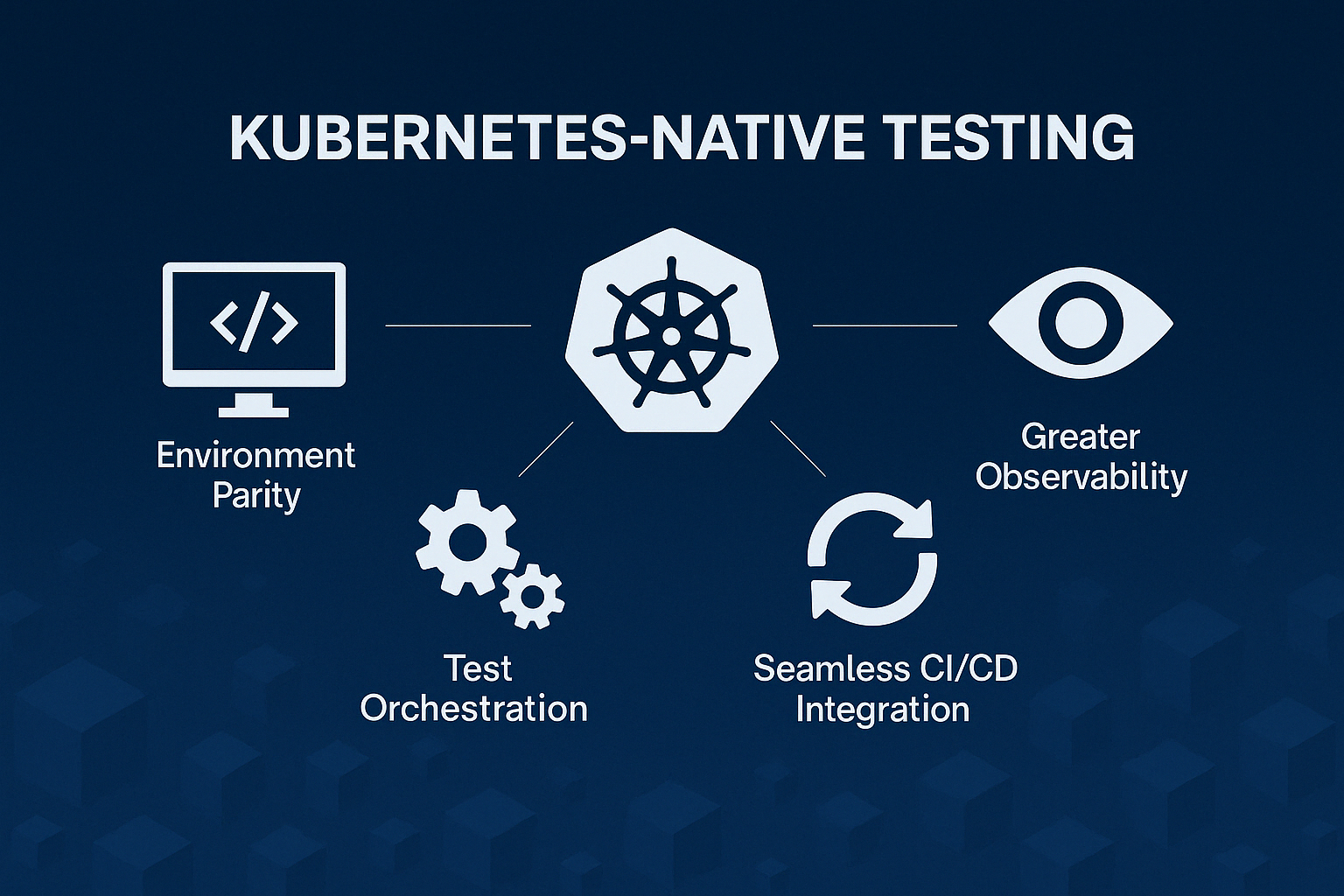

Table of Contents
Try Testkube instantly in our sandbox. No setup needed.




Table of Contents
Executive Summary
Testing Has Changed—Kubernetes Made Sure of It
Modern software development isn't what it used to be. As teams adopt microservices and move toward cloud-native architectures, the software testing process has had to evolve. In particular, Kubernetes clusters bring with them ephemeral environments, rapid deployment cycles, and decentralized services—a combination that can challenge even the most experienced testing teams.
Simply put: you can’t test Kubernetes-native apps with yesterday's tools. Legacy testing approaches struggle to keep up with the CI/CD pipelines, pull requests, and dynamic production environments that define Kubernetes. Today, testing must be continuous, automated, and built into your development and testing workflows from the start.
In this article, we’ll explore the testing challenges Kubernetes presents, how traditional methods fall short, and how tools like Testkube are helping teams embrace a new, more effective approach.
The New Challenges of Testing in Kubernetes
Deploying software in a Kubernetes cluster is radically different from a traditional monolith on a static server. With containers spinning up and shutting down constantly, maintaining stability and visibility during a test run can feel impossible without the right tooling.
Here are some of the most common issues that developers and testers face:
- Ephemeral test environments: A test environment in Kubernetes might only exist for a few minutes. That makes manual setup unreliable and unsustainable. Testing tools must work seamlessly with these short-lived environments.
- Service dependencies: You often can't test one microservice in isolation. You might need to spin up other services to support a single test case.
- CI/CD integration complexity: In a pipeline that deploys multiple times per day, your testing process must be automated and trigger reliably with each pull request.
- Observability gaps: Distributed systems often lack the centralized logs and metrics needed to debug failures quickly.
- Resource management: A poorly tuned performance testing job can monopolize resources and bring down other workloads.
These challenges are exactly why more teams are investing in Kubernetes-native testing tools that can integrate tightly with their CI/CD pipelines and scale as their infrastructure grows.
Why Legacy Testing Tools Fall Behind
Traditional testing platforms were never designed for dynamic, container-based environments. They often rely on static assumptions—like long-lived VMs, fixed IP addresses, and human-triggered test runs.
Some common pitfalls include:
- No cluster awareness: Legacy tools don’t know how to detect or respond to changes in your Kubernetes cluster.
- High setup overhead: Installing agents or configuring environments manually defeats the purpose of fast-moving DevOps workflows.
- Limited CI/CD compatibility: Integrating these tools into modern pipelines often requires complex workarounds.
- Poor observability: With no access to real-time logs or metrics, understanding test failures becomes guesswork.
Modern testing needs to be automated, observable, and Kubernetes-aware. And that's where Kubernetes-native platforms like Testkube come in.
What Is Kubernetes-Native Testing?

Infographic highlighting key benefits of Kubernetes-native testing: environment parity, test orchestration, CI/CD integration, and observability.
Kubernetes-native testing means running and orchestrating your software tests directly inside your cluster. It involves using Kubernetes resources like Jobs, Pods, and CRDs to run and manage your test cases.
It also means that your tests live as part of your infrastructure—they can scale, fail, restart, and be versioned just like any other part of your application.
Benefits of Kubernetes-Native Testing
- Environment parity: Run your unit tests, integration tests, and performance tests in the same cluster where your app lives.
- Orchestration and automation: Schedule, version, and monitor tests as Kubernetes-native workloads.
- CI/CD compatibility: Tests are easily integrated into your pipelines, ensuring every pull request is validated before merging.
- Observability: Collect real-time logs, test history, and performance metrics for debugging and optimization.
Explore more about Kubernetes-native testing.
Introducing Testkube: Testing Designed for Kubernetes
Testkube is a testing framework purpose-built for Kubernetes. It runs your existing testing tools (Postman, JMeter, k6, Cypress, and more) as native Kubernetes workloads—no special setup needed.
Testkube integrates directly with your CI/CD pipelines, GitOps tools, and development workflow to support all types of tests: from unit to integration to load testing.
- Explore supported test types
- Learn about test execution options
- Set up GitOps-based test management
What can you do with Testkube?
- Run test jobs as native Kubernetes resources
- Manage test definitions and configs in Git
- Trigger tests via API, CLI, UI, or GitOps events
- View detailed logs and test results in a centralized dashboard
Real-World Testing Scenarios in Kubernetes
Here are a few ways teams are using Testkube to modernize their testing:
- Post-deployment smoke tests: Run quick UI or API tests after a Helm or ArgoCD rollout.
- Isolated integration tests: Use to spin up dedicated test environments per pull request.
- Shift-left testing: Run critical test suites before merging changes to catch bugs early in the CI/CD pipeline.
- In-cluster performance testing: Launch distributed load tests from inside the Kubernetes cluster for realistic performance insights.
Best Practices for Kubernetes Testing
To get the most from your testing workflows in Kubernetes:
- Automate as much as possible, as early as possible
- Keep test environments as close to production as you can
- Use GitOps to manage and version your tests
- Embed testing into your CI/CD pipelines and track failures over time
Check out our full CI integration guide and test metrics dashboard to level up your approach.
The Future of Software Testing Is Kubernetes-Native
As more organizations move to microservices and Kubernetes-based delivery, the demand for scalable, flexible, and fast testing workflows will only grow.
Kubernetes-native testing is not just a nice-to-have—it's quickly becoming the new standard.
With tools like Testkube, you can reduce the time to release, boost developer productivity, and improve test coverage across every stage of development.
Get started with Testkube today.


About Testkube
Testkube is a cloud-native continuous testing platform for Kubernetes. It runs tests directly in your clusters, works with any CI/CD system, and supports every testing tool your team uses. By removing CI/CD bottlenecks, Testkube helps teams ship faster with confidence.
Explore the sandbox to see Testkube in action.





